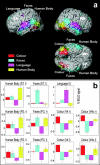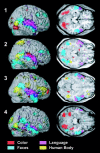Functional brain mapping during free viewing of natural scenes
- PMID: 14755595
- PMCID: PMC6872023
- DOI: 10.1002/hbm.10153
Functional brain mapping during free viewing of natural scenes
Abstract
Previous imaging studies have used mostly perceptually abstracted, idealized, or static stimuli to show segregation of function in the cerebral cortex. We wanted to learn whether functional segregation is maintained during more natural, complex, and dynamic conditions when many features have to be processed simultaneously, and identify regions whose activity correlates with the perception of specific features. To achieve this, we used functional magnetic resonance imaging (fMRI) to measure brain activity when human observers viewed freely dynamic natural scenes (a James Bond movie). The intensity with which they perceived different features (color, faces, language, and human bodies) was assessed psychometrically in separate sessions. In all subjects different features were perceived with a high degree of independence over time. We found that the perception of each feature correlated with activity in separate, specialized areas whose activity also varied independently. We conclude that even in natural conditions, when many features have to be processed simultaneously, functional specialization is preserved. Our method thus opens a new way of brain mapping, which allows the localization of a multitude of brain areas based on a single experiment using uncontrolled, natural stimuli. Furthermore, our results show that the intensity of activity in a specialized area is linearly correlated with the intensity of its perceptual experience. This leads us to suggest that each specialized area is directly responsible for the creation of a feature-specific conscious percept (a microconsciousness). Hum. Brain Mapp. 21:75-83, 2004.
Copyright 2003 Wiley-Liss, Inc.
Figures







References
-
- Bar M, Tootell RB, Schacter DL, Greve DN, Fischl B, Mendola JD, Rosen BR, Dale AM (2001): Cortical mechanisms specific to explicit visual object recognition. Neuron 29: 529–535. - PubMed
-
- Bartels A, Zeki S (2000): The architecture of the colour centre in the human visual brain: new results and a review. Eur J Neurosci 12: 172–193. - PubMed
-
- Bartels A, Zeki S (2003): The chronoarchitecture of the human brain—functional anatomy based on natural brain dynamics and on the principle of functional independence In: Frackowiak R, Friston K, Frith C, Dolan R, Zeki S, editors. Human brain function, 2nd edition UK: Academic Press; p 201–229.
-
- Beauchamp MS, Haxby JV, Jennings JE, DeYoe EA (1999): An fMRI version of the Farnsworth‐Munsell 100‐Hue test reveals multiple color‐selective areas in human ventral occipitotemporal cortex. Cereb Cortex 9: 257–263. - PubMed
Publication types
MeSH terms
Grants and funding
LinkOut - more resources
Full Text Sources
Other Literature Sources

